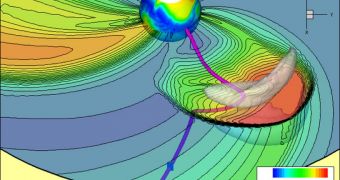A team of experts made an amazing announcement at a dedicated conference today, when they said that the first space weather prediction model went online recently. The instrument will aid solar physicists get a 1-to-4-day forecast about how the Sun will behave.
The simulation is heavily based on physics, and is the first tool of its type to work at such a large scale. The model has reportedly just finished transitioning from he research to the operations phase.
The announcement was made today, January 26, at the annual American Meteorological Society (AMS) meeting, that is being held in Seattle, Washington – by experts from the Center for Integrated Space Weather Modeling (CISM).
The team at the National Science Foundation (NSF) Center works closely with colleagues from the National Weather Service. Representatives from both institutions reported on the progress today.
According to the scientists, the model will be able to produce advanced warnings of high speed streams of solar plasma and Earth-directed coronal mass ejections (CME) that might originate on the Sun.
Given the devastating effects that such emissions can have on our planet if they pass through the magnetosphere, gaining this capability is forthcoming. Solar flares can cause disruptions of satellite communications, widespread destruction in power grids, and so on.
CISM has been studying the Sun-to-Earth space weather for about 9 years. It is made of 11 individual research institutions and organizations, which worked together on the new computer model.
“It's very exciting to pioneer a path from research to operations in space weather. The science is having a real impact on the practical problem of predicting when 'solar storms' will affect us here on Earth,” says Jeffrey Hughes.
The expert holds an appointment as a research scientist at the Boston University, and he is also the director of CISM. The Center worked closely for the simulation with the National Oceanic and Atmospheric Administration (NOAA) Space Weather Prediction Center.
“This milestone represents important scientific progress, and underscores the effectiveness of NSF's Science and Technology Centers in applying research results to real-world problems,” explains Robert Robinson.
He is based at the NSF Division of Atmospheric and Geospace Sciences, one of the organizations funding the CISM.

 14 DAY TRIAL //
14 DAY TRIAL //